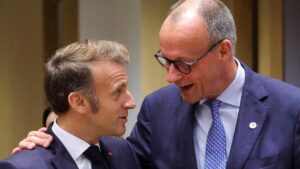
“Please help us stop the fire. The situation is dramatic. (…) Tell the public, so that the president gives the order”, pleaded Alfonso Reyes Echandía, president of the Supreme Court of Justice of Colombia, on Radio Todelar. It was the afternoon of November 6, 1985 and the headquarters of his country’s judicial power, the Palace of Justice in Bogota, was a war camp. 35 guerrillas of the M-19, a group of urban origin and victim of media attacks, had entered with blood and fire with the banner of forcing the magistrates to hold a “trial” of President Belisario Betancur, accused of having betrayed them in a peace negotiation already doomed to failure. The reaction, which the president left in the hands of the military, was even bloodier. The building ended up burned, 11 of the 25 Supreme Court judges were murdered, and thousands of files of all kinds were lost.
In a long history of political violence like that of Colombia, the events at the Palace remain particularly relevant. Even more so than other more deadly and more recent episodes. In 1989, for example, drug trafficker Pablo Escobar blew up a plane taking off from Bogotá to Cali, causing 110 deaths. In 2000, according to the Prosecutor’s Office, paramilitaries devastated the city of El Salado, in the Caribbean region, causing the death of over 100 people. And in 2002, FARC guerrillas attacked the church in the town of Bojayá, in Chocó, and killed at least 74 civilians. The circumstances, due to the location of the attack, the political importance of the victims or the visibility of what happened, make the difference. And this is why an episode that in Colombia has been called a “holocaust” has occupied the attention of journalism and the arts, comparable only to the murder of Jorge Eliécer Gaitán, on April 9, 1948, and the subsequent Bogota murder.
Furthermore, the judiciary experienced the attack as a permanent pain. The murdered magistrates were colleagues, professors, bosses and even relatives of many lawyers of subsequent generations, and their deaths left an imprint that justice still regrets today.
In addition to this open wound, the debate on the kidnapping and recovery is so current and combative that President Gustavo Petro participates in it, who was a member of the same M-19 and, although he did not participate in the kidnapping, defended a story that reduces the responsibility of his former comrades. The issue is so sensitive that a judge recently ordered the elimination of dialogue from a film about the Palace; It is so valid that this Wednesday, former president Álvaro Uribe Vélez proposed a new rule “which guarantees the soldiers who participated in the rescue of the Palace of Justice, convicted or still under investigation or trial, all the benefits equivalent to acquittal”.
The relevance of what happened four decades ago implies unanswered questions. One of these concerns the protection of magistrates. Although a guerrilla plan to attack the Palace was revealed, which made headlines, as several magistrates received death threats, security at the Palace was reduced on 5 November.
Another question without a clear answer concerns the reasons for the attack. M-19 issued a proclamation from the Palace on what it called Operation Antonio Nariño for Human Rights. “We demand the public trial of stateless minorities who have defrauded the desire for peace and betrayed the needs of progress and social justice of the entire nation,” he says in one of his central sentences, and then demands that the mainstream media broadcast the trial they dreamed of. “Dear magistrates: you have the great opportunity, in front of the country, and in your capacity as the great moral reserve of the Republic, to preside over a memorable trial”, we then read.
But the shadow of drug trafficking hovers over what has happened since 1985, when the guerrillas accepted a request from the drug traffickers. “Through a scandalous and unpopular extradition treaty, our legality is guaranteed – the most innovative and growing of all renditions – which represents a mortal blow against national sovereignty,” the same proclamation reads. However, especially people close to Pablo Escobar said that the leader paid the guerrillas for the attack, trying to prevent the Supreme Court from approving that treaty, which they opposed with blood and fire. Whoever the lieutenant was, Jhon Jairo Velásquez, Popeyeit is one of those sources; Others were drug-loving Virginia Vallejo or paramilitary leader Carlos Castaño. The question remains in the air, as there is no evidence nor is it clear that an atrocity of this type would have the expected effect. The closest thing to an answer, according to a Truth Commission formed by the High Courts in 2005 to shed light on the events at the Palace, is to point it out as a probable hypothesis. “Everything indicates, therefore, that there was a connection between the M-19 and the Medellín cartel for the assault on the Palace of Justice,” reads the final report.
A third question is to what extent the military assumed real power in those hours. The then Minister of Justice, the liberal politician Enrique Parejo, argued that there was a power vacuum in which the generals decided what to do. But his then government colleague, Jaime Castro, published a book in which he argued that no such thing existed and that the decision to respond with force came from Betancur and his government, who feared that engaging in guerrilla warfare would lead them to stage a popular uprising and seize power.
The fourth question revolves around the responsibility for every murder, every disappearance, every decision in the over 27 hours of fighting and fires. Investigators, journalists and interested parties encountered all kinds of problems in finding sufficient evidence of what happened. In some cases witnesses give conflicting versions; in others, the witnesses have died – in those days, or in the intervening four decades –; In some cases, the lack of ballistic tests or the manipulation of the Palace by the police and military before the arrival of judicial officials prevents obtaining sufficient technical evidence.
Perhaps the most significant of the unanswered questions, which range from the judicial to the political, is whether the military knew the M-19 would carry out the attack and allowed it to happen, in order to hit the M-19 hard in what some have called an “operation mousetrap.” Although the generals have repeatedly denied it, the three magistrates who led a commission to investigate the facts between 2005 and 2010 give credence to this move. “The Truth Commission considers this hypothesis to be one of the most probable,” we read in its final report. Jorge Aníbal Gómez, José Roberto Herrera and Nilson Pinilla point out that the Army has been “irritated in its dignity” and “wounded in its self-esteem” by the past actions of a particularly media-intensive guerrilla war. Others added that the military was angry with the president, who had continued peace talks without consulting them and against their opinion.
The most complex thing, according to former minister Buitrago, is that the answers to these questions have changed, leaving a legacy of mistrust and little credibility, as when the military denied knowing about the M-19 plan. And this keeps the wounds alive and open.





